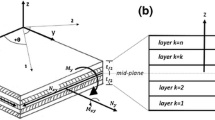Abstract
The joints connecting vertical and horizontal elements are the “weak link” in structural systems assembled from wood panels. If they are too weak, local failures may occur, resulting in performance that is significantly below expectations. If they are too resistant, the joints may be unable to dissipate energy during vibrations, thus possibly initiating a fast progressive failure. This paper re-processes and re-elaborates the results of shaking table tests previously carried out by the author and other co-workers. The goal is to assess the feasibility of a joint which is able to dissipate energy during vibration, without degrading the connection performance.
Similar content being viewed by others
References
André N, Castéra P and Galimard P (2003), “Introduction of Probabilistic Tools in the Evaluation of Wooden Historical Buildings, in Terms of Safety: A Case Study,” Proceedings of the 3rd World Conference on Structural Control, Vol.2, Casciati F. (ed.), Chichester: John Wiley & Sons, pp. 1127–1136.
Bendat JS and Piersol AG (1986), Random Data: Analysis and Measurements Procedures, New York: John Wiley & Sons, USA.
Breyer DE, Fridley KJ and Cobeen KE (1998), Design of Wood structures, 4th ed., New York: McGraw Hill.
Casciati F (2003), Proceedings of the 3rd World Conference on Structural Control, Chichester: John Wiley & Sons.
Castera F (2005), Proceedings of the International Conference on Probabilistic Models in Timber Engineering, Arcachon, France; ARBORA, Cestas, France.
Casciati F, Casciati S and Domaneschi M (2005), “Wood-panel Smart Joints for Dynamic Excitations,” Proceedings of the International Conference on Probabilistic Models in Timber Engineering, Arcachon, France; ARBORA, Cestas, France, 273–281.
Casciati F and Castera P (2007), Structural Safety, 29(4): 253–348.
Casciati F and Faravelli L (1991), Fragility Analysis of Complex Structural Systems, Taunton, Research Studies Press.
Casciati F, Magonette G and Marazzi F (2006), Semiactive Devices and Applications in Vibration Mitigation, Chichester: John Wiley & Sons.
Casciati S and Faravelli L (2007), “Structural Components in Shape Memory Alloy for Localized Energy Dissipation,” Computers & Structures (in press).
Foschi RO, Folz BR and Yao FZ (1989), “Reliability-based Design of Wood Structures,” Structural Research Series, N. 34, University of British Columbia, Vancouver, Canada.
Giordano G (1999), Tecnica delle Costruzioni in Legno (in Italian), Hoepli, Milan, Italy.
Hou Z, Suzuki Y and Shimizu H (2003), “Damage Detection of a Wooden House During Shaking Table Testing Using Wavelet-based Approach,” Proceedings of the 3rd World Conference on Structural Control, Casciati F (ed.), Vol. 2, pp. 1121–1126.
Author information
Authors and Affiliations
Corresponding author
Additional information
Supported by: Italian National Research Council (CNR) Under Grant No. CU07.00016 ST/97
An erratum to this article is available at http://dx.doi.org/10.1007/s11803-007-0789-0.
Rights and permissions
About this article
Cite this article
Casciati, S. Nonlinear aspects of energy dissipation in wood-panel joints. Earthq. Engin. Engin. Vib. 6, 259–268 (2007). https://doi.org/10.1007/s11803-007-0764-9
Received:
Accepted:
Issue Date:
DOI: https://doi.org/10.1007/s11803-007-0764-9




